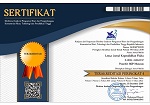Development of Powtoon Animation Videos for STEM-Integrated Physics Learning and Its Impact on Student Learning Outcomes
DOI:
https://doi.org/10.33394/j-lkf.v12i2.11764Keywords:
STEM-integrated learning, Powtoon animated videos, Physics education, Student learning outcomes, Educational technologyAbstract
This study aimed to develop Powtoon animated videos for STEM-integrated physics learning and assess their impact on student learning outcomes. The Research and Development (R&D) method, using the ADDIE model, was employed to systematically develop and evaluate the instructional media. The study involved five phases: analysis, design, development, implementation, and evaluation. During the analysis phase, needs were identified based on observations of students' difficulties in understanding abstract physics concepts and their disengagement from traditional teaching methods. The videos were developed to integrate scientific, technological, engineering, and mathematical (STEM) concepts, focusing on simple machines such as levers and pulleys. Expert validation was conducted to assess the quality of the videos, and revisions were made accordingly. The implementation phase involved a pretest-posttest control group design with eighth-grade students from SMP Negeri 2 Watumalang. The experimental group used the STEM-integrated Powtoon videos, while the control group received traditional instruction. Data were analyzed using a t-test and N-Gain to measure the improvement in student learning outcomes. Results showed a significant improvement in the experimental group’s post-test scores, with an average N-Gain of 66.95%, categorized as moderately effective. The control group had a lower average N-Gain of 49.22%, categorized as less effective. The findings demonstrate that the Powtoon videos not only enhanced students' conceptual understanding but also increased their motivation and engagement in physics learning. These results suggest that integrating STEM principles into instructional media, such as animated videos, is an effective strategy for improving learning outcomes in physics. The study recommends expanding the use of such multimedia approaches across other STEM-related subjects to foster critical thinking and problem-solving skills in students.References
Anam, A. (2019). Pengembangan Video Pembelajaran Fisika Channel Youtube Berbantu Aplikasi Powtoon pada Materi Suhu dan Kalor. Lampung: Doctoral dissertation, UIN Raden Intan Lampung.
Fitriyani, N. (2019). Pengembangan Media Pembelajaran Audio-Visual Powtoon Tentang Konsep Diri dalam Bimbingan Kelompok untuk Peserta Didik Sekolah Dasar. Jurnal Tunas Bangsa, 104-114.
Hake, R., R. (1999). Analyzing change/gain scores. Indiana University: Woodland Hills, CA - USA
Murdani, E. (2020). Hakikat Fisika dan Keterampilan Proses Sains. Jurnal Filsafat Indonesia, 3(3), 72-80.
Muttaqiin, A. (2023). Pendekatan STEM (Science, Technology, Engineering, Mathematics) pada Pembelajaran IPA Untuk Melatih Keterampilan Abad 21 . Jurnal Pendidikan MIPA , 34-45.
Okyranida, E. D. (2021). Pengaruh Model Pembelajaran Berbasis Proyek terhadap Hasil Belajar dan Respon Siswa Pada Materi Gelombang kelas VIII MTs Negeri 9 Blitar . Journal of Physics Education , 94-48.
Primayana, P. Y. (2019). Effect of Learning Module with Setting Contextual Teaching and Learning to Increase the Understanding of Concepts. International Journal of Education and Learning, 19-26.
Ridwan, M. Z. (2021). Pengembangan Media Pembelajaran Interaktif Berbasis Model Problem Based Learning untuk Meningkatkan Kemampuan Berfikir Kreatif Fisika Peserta Didik. Jurnal Hasil Kajian, Inovasi, dan Aplikasi Pendidikan Fisika, 7(1), 103-108.
Roebianto, R. (2020). The Effects of Student’s Attitudes and Self-Efficacy on Science Achievement. Jurnal Pengukuran Psikologi Dan Pendidikan Indonesia , 1-10.
Setiani, M. H. (2021). Persepsi Peserta Didik Terhadap LKPD Terintegrasi STEM pada Materi Suhu dan Kalor. Jurnal Penelitian dan Pengembangan Pendidikan, 287-293.
Sugiyono, S. (2015). Metode Penelitian Pendidikan. Bandung: Alfabeta.
Sugiyono, S. (2017). Metode Penelitian Kuantitatif Kualitatif dan R&D. Bandung: Penerbit Alfabeta.
Syawaludin, S. (2019). Development of augmented reality-based interactive multimedia to improve critical thinking skills in science learning. international journal of instruction, 331-344.
Wafiq, H. R. (2021). Pengembangan Media Pembelajaran Game Edukasi Berbasis Android Pada Mata Pembelajaran Fisika Dengan Model Prototipe. JIPI (Jurnal Ilmiah Penelitian dan Pembelajaran Informatika) , 448 – 456.
Wardani, H. N. (2024). Video Animasi Elastisitas dan Hukum Hooke (Vantase) Berbasis Project Based Learning. Prosiding Seminar Nasional Fisika (E-Journal), 115-120.
Yoshua, R. I. Y. (2022, Mei 30). Pengembangan Video Pembelajaran Animasi Fisika Berbasis Powtoon Pada Materi Pemanasan Global. Jurnal Ilmiah Mahasiswa Pendidikan Fisika, 3(1), 72-29.
Downloads
Published
How to Cite
Issue
Section
License
Authors who publish with Lensa: Jurnal Kependidikan Fisika agree to the following terms:
- For all articles published in Lensa: Jurnal Kependidikan Fisika, copyright is retained by the authors. Authors give permission to the publisher to announce the work with conditions. When the manuscript is accepted for publication, the authors agree to automatic transfer of the publishing right to the publisher.
- Authors retain copyright and grant the journal right of first publication with the work simultaneously licensed under a Creative Commons Attribution-ShareAlike 4.0 International License that allows others to share the work with an acknowledgment of the work's authorship and initial publication in this journal.
- Authors are able to enter into separate, additional contractual arrangements for the non-exclusive distribution of the journal's published version of the work (e.g., post it to an institutional repository or publish it in a book), with an acknowledgment of its initial publication in this journal.
- Authors are permitted and encouraged to post their work online (e.g., in institutional repositories or on their website) prior to and during the submission process, as it can lead to productive exchanges, as well as earlier and greater citation of published work (See The Effect of Open Access).

This work is licensed under a Creative Commons Attribution-ShareAlike 4.0 International License.



